Recipe #17: Tatale (ripe plantain pancakes)
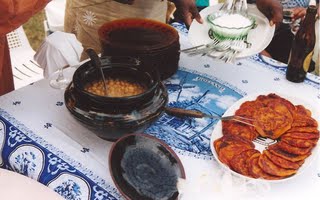 I'm partial to versatile ripe plantains. One of my favorite ways to cook (and eat!) them is as a simple savory (no syrup, please) pancake as in this photo from a party in Ghana.
I'm partial to versatile ripe plantains. One of my favorite ways to cook (and eat!) them is as a simple savory (no syrup, please) pancake as in this photo from a party in Ghana.The first, and possibly the hardest, step is to find ripe-to-overripe plantains. In colder weather in central Pennsylvania this is difficult. I'm not sure if the imported green plantains are held at too cold a temperature or something, but half the time the plantains will not ripen, even if you put
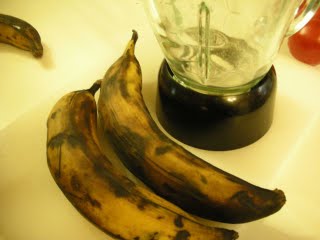 them in a paper bag with apples, keep them in a warm room, in sunlight, etc.), but just get wooden and rot. In the summer I rarely have that
them in a paper bag with apples, keep them in a warm room, in sunlight, etc.), but just get wooden and rot. In the summer I rarely have that 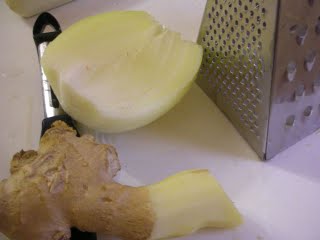 problem. However, I generally buy twice as many plantains as I need two or three weeks before I need them ripened.
problem. However, I generally buy twice as many plantains as I need two or three weeks before I need them ripened.I cooked tatale (aka tetare) a couple of weeks ago, and made boiled bambara beans to go with them. This is a classic way to eat tatale in Ghana. It's also the only dish I know of, apart from porridge, where sugar is served on the side and may be added to taste (though some purists insist that even that's a foreign intrusion).
BTW, I didn't have any rice flour so I threw some long grain rice into a blender and made my own. It worked fine. You may also substitute cornmeal for all or part of the flours.
Here's the basic recipe:
3 or 4 large over-ripe plantains, about 1 1/2 lbs. after peeling), or about 3 cups when sliced
4 oz. of onion (about 2 medium), or shallots, finely grated
2 oz rice flour (about 1/3-1/2 cup)
2 oz wheat flour (about 1/2 cup)
2 t dried ground red cayenne pepper (more or less to taste)
3 t fresh grated or ground ginger
about a cup of oil for pan frying (palm oil is traditional if you can get it. I usually make these on a nonstick electric griddle so I don't need too much)
1/4-1/2 t salt (optional)
a cup of water
For equipment, I recommend:
paper towels, for draining the pancakes (that's because I don't want too much oil. They would likely omit this step in Ghana);
a frying pan or griddle (nonstick is nice);
something to mash the plantains (I would've used a potato masher but it's still in boxes since our last sabbatical, so I ended up squeezing them through a potato ricer and then mashing them with a fork. A mortar and pestle would also work (they use a rounded wooden mortar in Ghana), but I'd stay away from a blender or food processor if you want the proper texture (if that doesn't bother you, blend away);
a knife
a grater (for the ginger and onion)
a cup
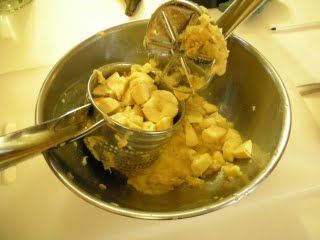
Directions:
Cut the ends off, and make a horizontal slit along one side, then peel each of the plantains and slice them into slices about 1/4 - 1/2 inch thick. As mentioned above, traditionally these would then be pounded in a mortar with a wooden pestle. It should not be completely smooth. If you feel you must use a blender or food processor, keep some of the plantain out and mash it and add it after you've blended the rest.
Stir in the grated ginger, dried red pepper and grated onions. Add the rice and wheat flours (or cornmeal if you prefer). Add a cup of water and stir again.
It's good to let the mixture sit for 20 - 30 minutes before you cook the pancakes. The batter can actually be made a day ahead and refrigerated until you're ready to cook the tatale.
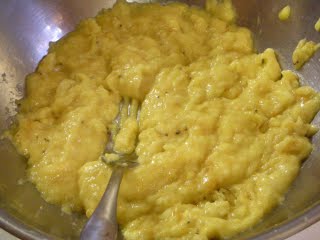
Heat a heavy frying pan or griddle as you would for regular pancakes (medium high heat). I use a pastry brush to brush palm oil on the pan, then drop the batter onto the griddle (either small, like "silver dollar" pancakes, or somewhat larger, say using 1/3 to 1/2 cup batter.) I usually use a spoon to spread the batter into a circle shape.
As soon as the tatale is firm enough to turn without breaking, carefully turn it over with a pancake turner and press the turner down firmly on the pancake to flatten it. Continue doing this every few minutes while the pancakes cook.
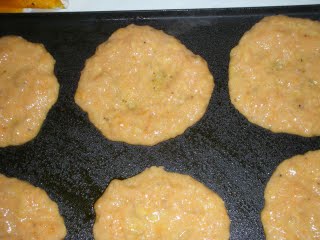
Drain the pancakes on paper towels and add a little more oil to the pan for each batch of tatale. Avoid stacking them--spread them out to drain, and serve them on a large platter. The tatale can be made in the morning and kept warm in a low oven, but will become tough if heated too long. A better alternative is to zap them briefly in the microwave to heat them before serving them. Both Barbara and I like our tatale quite brown, but if you prefer it less crusty, cook it to suit your taste.
Serving suggestions:
The classic way to serve tatale is with boiled bambara beans (aboboe) as in the photo above, or bean stew. Tatale and aboboe is a wonderful, elegantly simple party snack, especially pleasant when washed down with cold glasses of beer. It is also hearty enough for nonvegetarians to adore. Peanuts supplanted bambara beans in much of West Africa. I'll bet if you boiled fresh peanuts you'd get a tasty substitute, though I've never tried it. I usually serve tatale with bean stew since it's difficult for me to get dried bambara beans. Some organic farmers in my town tried to grow some for me, but the plants did never fruited. Watch for recipes for boiled bambara beans and bean stew soon.
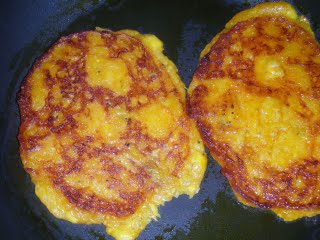
Labels: bambara beans, pancakes, plantain, tatale, tetare


2 Comments:
mmm... this sounds great. I'll let you know how my effort turned out! Sonds like something I'd put hot sauce on, not syrup!
Exactly, Michael. I recommend you up the red pepper to a tablespoon.
Post a Comment
<< Home